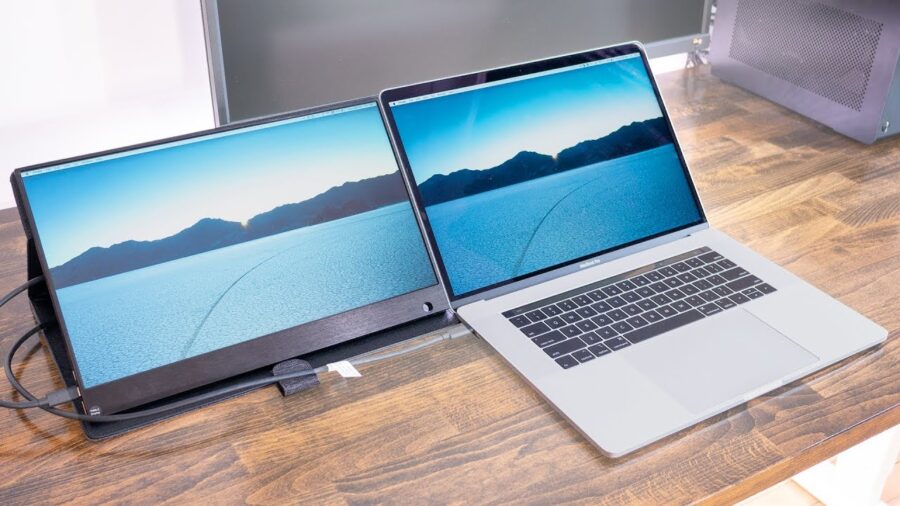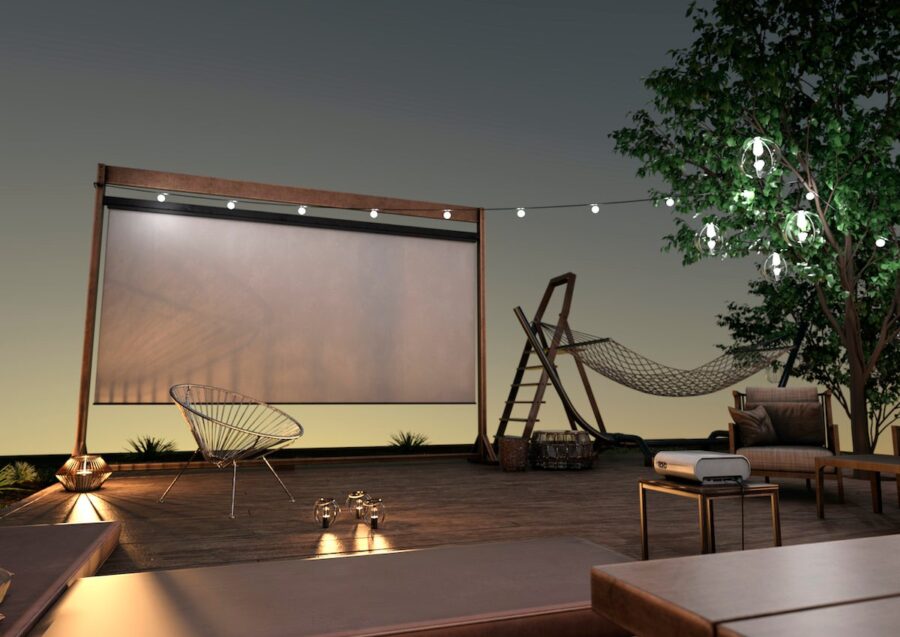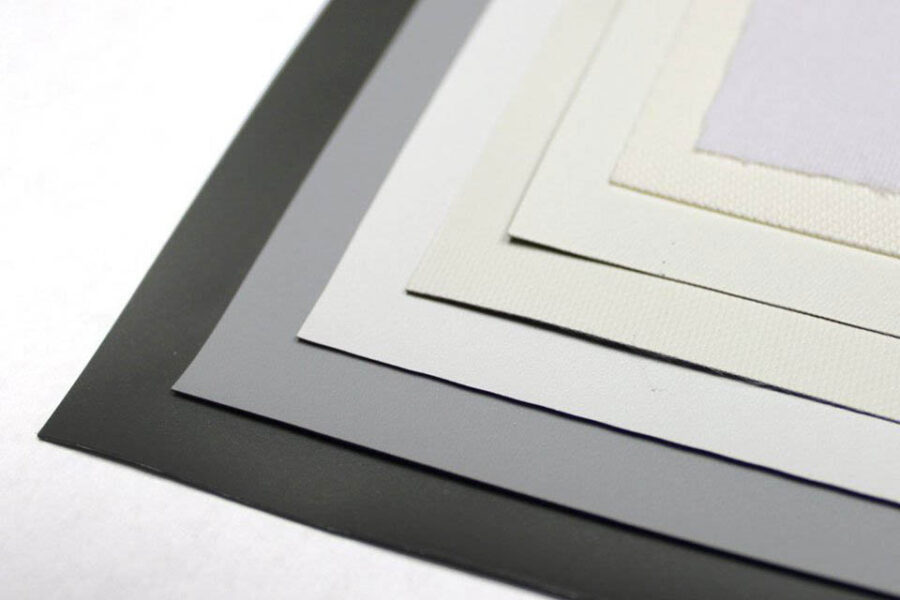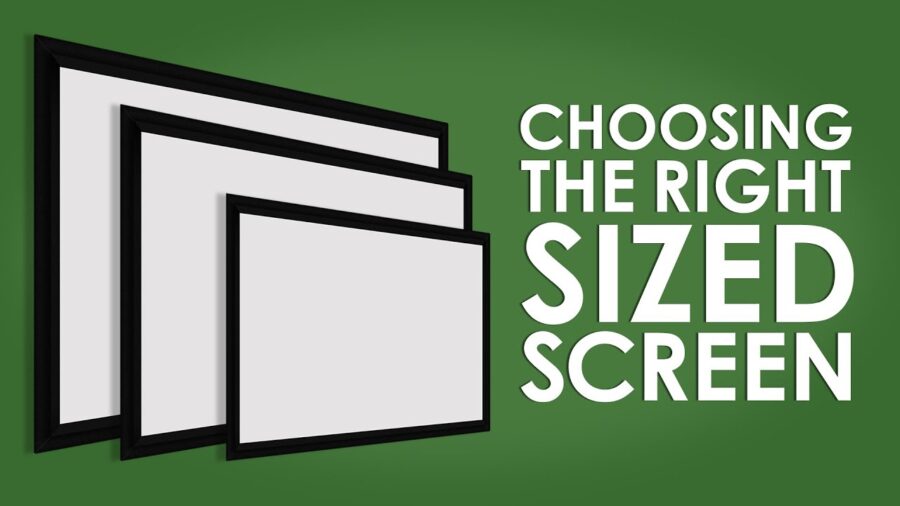Projector screens are essential components of a great home theater system and the choice of which one to buy can be difficult. There are many different types of projector screens of varying sizes and materials available, so finding the right one for your needs can be tricky. This post will provide some insight on what to look for in a projector screen and explain the different options out there to help you make the right decision. We’ll break down the pros and cons of the various types of projector screens available and explain how different screens can affect the viewing experience. By the end of the post you’ll know exactly which projector screen is best suited to meet your requirements – whatever they may be!
The best materials for making a projector screen that would compliment your Epson home theater projector are white linen or Da-Lite’s Matte White fabric. Choosing the right material will depend on your needs such as size, portability and cost, so consider what works best for you before deciding.
When it comes to projector screens, there are several types to choose from. Each type has its own set of advantages and disadvantages, so it’s important to familiarize yourself with the different options before making a decision.The most common type of projector screen is the traditional wall-mounted option. This type of screen offers a good picture quality with a wide viewing range, making it a suitable choice for many home theater projections. One of the main benefits of this type of projection is that it is relatively inexpensive and easy to install—all you need is a few pieces of mounting hardware you can purchase from your local hardware store.
The downside is that wall-mounted projector screens require additional space for mounting and can’t be moved or adjusted once installed.Another option is the portable projector screen. Portable projector screens are ideal for anyone who needs the flexibility to move their equipment or hold events in different locations. Portable projector screens are typically made from lightweight materials such as cloth, meaning they can be folded up for easy storage and transportation. However, the tradeoff for portability is that these screens tend to lose image quality when stretched over long distances, which may not make them suitable for more intensive home theater applications.Finally, there are motorized projector screens which offer automated setup and take-down operations as well as adjustable height settings so you can customize the size of your screen according to your individual preferences.
While these types of screens are more expensive than other models, they make up for the extra cost in convenience given that they don’t require any manual setup or takedown operation.When selecting a projector screen, it’s important to consider your specific needs before making a choice. Depending on your budget, space constraints and usage requirements, any one of these types could be the perfect fit for you. That said, our next section will delve into the details about one type of projector screen in particular – portable screens.
Portable Screens

Portable screens are a great option when you don’t have the space or budget for a permanent projector setup. Portable screens are usually lightweight and affordably priced, allowing even more casual users to enjoy the satisfaction of viewing films comfortably from their own couches. Additionally, these screens can offer a variety of image qualities depending on the size and material.
Portable screens are ideal for those who may need to set up a projector larger than what their home can accommodate or may want to rearrange their setup over time. In contrast, permanent installations would require more effort and money for removing or fixing any issues that might arise. Furthermore, portable screens require minimal setup and installation which is perfect for situations where an immediate presentation is needed. However, there is one downside – they are not as durable as fixed screens, therefore they may not produce the highest image quality possible.Overall, portable screens offer convenience, affordability, minimal setup requirements and substantial image qualities depending on the model chosen.
Nevertheless, potential drawbacks need to be considered such as durability and potential lack of contrast compared to permanent solutions. Moving on to our next section, let’s explore the pros and cons of permanent projector screens and how they compare to their portable counterparts.
Permanent Screens
Permanent screens provide a dedicated viewing surface that helps to maximize image quality, making them a popular choice for home theater systems. They are usually wall-mounted or ceiling mounted, with special framing and fabrics designed to give enhanced contrast, better black levels and improved color saturation.
Permanent projection screens can be motorized or manual in terms of operation, allowing for a retractable setup that rolls up when not in use. Some even come with in-built speakers and control systems.One benefit of permanent projector screens is that they are aesthetically pleasing when installed, creating a professional appearance within the theater room. In addition, they minimize light reflections off of walls and furniture, ensuring an optimal viewing experience.
On the other hand, these screens often require professional installation, which adds additional cost to the setup and may limit where it can be positioned. Furthermore, even after installation some maintenance is required; dirt and dust can accumulate on the screen surface over time, which affects projection quality.Overall then, while permanent projector screens offer high image quality and attractive aesthetics they may not be suitable for every home theater setup due to their significant installation requirements and pricier nature. The next section looks at outdoor projector screens as a viable alternative for those wanting to utilize projection outdoors or on a budget.
- According to a 2020 study, the most widely used material for a projector screen is Matte White Vinyl with a gain of 1.1.
- A recent survey found that 96% of respondents preferred using vinyl Projection Screens instead of non-vinyl or acrylic screens.
- Studies have shown that Matte White Vinyl has better light transmission properties than all other materials and results in sharper images.
Outdoor Projector Screens

Outdoor projector screens have grown in popularity with technology becoming more accessible and more portable. An outdoor projector screen can be a great way to enjoy a movie or sports game with friends and family without having to go to a movie theater. Outdoor projector screens are an increasingly popular choice for creating an entertaining viewing experience for larger audiences, with HD video quality often exceeding that seen inside.
But before you invest in an outdoor projector screen, there are several things to consider.Advantages of Outdoor Projector ScreensThe main advantage of using an outdoor projector screen is the ability to gather larger groups of people together to watch movies or videos in the fresh air and natural sunlight. Outdoor projector screens don’t just make watching movies outdoors possible; they also help create a true cinematic experience outside your home. Additionally, some outdoor surfaces such as garage doors provide extra flexibility, allowing you to view a movie during the day and store away when no longer needed.Disadvantages of Outdoor Projector ScreensOn the other hand, there can be drawbacks when opting for an outdoor projector screen instead of setting up indoors.
It requires taking into consideration the weather conditions — if dark clouds or rain roll in, it might bring your outdoor movie night to an unfortunate end! Also, it is important to note that outdoor projector screens do not offer the same level of brightness as indoor models, which means you will have to adjust your projector’s brightness settings accordingly.Overall, an outdoor projector screen may be a great way to gather larger crowds together for movie nights and sporting events under the open skies. However, some factors should still be taken into consideration when deciding if an outdoor projection screen is right for you.Now that you know the pros and cons of choosing an outdoor projector screen, next we’ll explore what material you should choose for your own particular setup.
What Material Should You Choose for Your Projector Screen?

When choosing a material for your projector screen, consider both the affordability and performance of each material. It is important to know what you are willing to sacrifice for a more economical choice, or if you are willing to pay extra for an improved viewing experience.Cloth or Fabric: Cloth surfaces offer smooth texturing and bright colors. These materials usually come pre-stretched, but it is important to make sure that the fabric of the screen does not block the projected image quality.
For a better viewing experience, this type of surface should be laminated to prevent photographic warping due reader notice: To ensure that your family enjoys the best possible viewing experience, we recommend investing in a matte fabric projector screen.Matte Vinyl: Matte vinyl tends to be less expensive than traditional cloth or fabric screens, as they can be installed much quicker and therefore require less labor. However, these types of screens are not as durable because they scratch and mark easily.
A lot of ambient light can also cause the edge of the projected picture to bend and blur unless an anti-glare coating is used.Rigid Projector Screens: Rigid screens offer an incredibly strong surface in comparison with fabric or vinyl alternatives. They are often referred to as “Hybrid” screens because they provide both reflectivity from paints/coatings and rigidity from hardboard substrates. This makes them very durable and able to withstand even harsher conditions compared to other materials. Although rigid screens tend to cost more and could require professional installation for optimal results, ultimately they provide superior viewing experience when compared with other alternatives.
No matter which material you choose for your projector screen, it is important to do your research and understand what you’re sacrificing in terms of performance or affordability. With all of these options available on the market today, you should be able to find something that meets both your needs and budget. Now let’s take a deeper look into one particular type of surface material – matte fabric projector screens – in the next section.
Matte Fabric
When it comes to projector screens, matte fabric is quickly becoming the tried and true go-to in terms of home theater setups. Matte fabric is a screen material that uses either synthetic or organic yarns woven into the fabric, resulting in an incredibly smooth surface ideal for projecting large images onto, with many even coming with a treated surface that helps improve image quality further.
Brightness isn’t sacrificed either; when compared to other surfaces, matte fabric retains excellent color accuracy and contrast.There are a few quibbles worth noting here. For one thing, matte fabric may have difficulty displaying certain kinds of media, like glossy photos or fine text. While they can still be presented relatively clearly on the screen, some artifacts or smudging may appear onscreen (although this will vary from fabric to fabric). A more pressing concern is price; since these fabrics are complexly woven together out of synthetic and/or natural fibers, prices for quality models can run high.
That being said, a good matte fabric projector screen can be a great choice for those seeking a great home theater experience without sacrificing too much money. With its excellent visuals, wide availability at different prices points, and easy installation, matte fabric stands out among other materials as one of the premier choice for projecting large images in your own home.And now that we’ve discussed the benefits and limitations of matte fabric projector screens let’s move onto the next best option: paint…
Key Points to Know
Matte fabric projector screens are an ideal choice for a home theater experience due to their smooth surfaces, excellent visuals, wide availability and easy installation. However, drawbacks include difficulty displaying certain media, such as glossy photos or fine text, as well as a potentially high price tag. Paint is also an option that is worth considering.
Paint
When considering the best options for a projector screen, one of the most cost-effective and adaptable solutions is to consider using paint. Using paint as a projected surface eliminates the need to purchase additional materials, and offers the potential to customize an entire wall of your home theater according to your exact size specifications.Some might argue that the quality of paint may degrade over time and therefore affect viewing quality.
The truth is that modern paints are designed with certain additives which allow them to remain projection-ready for much longer than before. However, there is some maintenance involved with paint-based projection surfaces as any dirt accumulation or fading has the potential to reduce image quality. It must be noted that there are speciality paints available on the market which may improve durability over standard interior paints.It’s also important to take into account that some subtle color changes between hues or tints of the same color can have an appreciable effect on image clarity and color rendition.
For those who are picky about their viewing experience, it is highly recommended to use swatches from sample cans or websites from trusted source before committing to an entire wall of projection size.On the other hand, some may find that paint is too difficult to work with and not always suitable for rooms in which children often play or live animals spend much time. In these cases where wear resistance and washability are necessary, alternatives such as wallpaper may be more appropriate and will be discussed in following section.
Wallpaper
Wallpaper can be a great, cost-effective solution for a projector screen. Wallpapers made from synthetic fabrics are especially suitable, as they have the perfect material finish to maximize image quality while still allowing light to pass through easily. The best wallpapers will be black and matte, as these colors will minimize any reflections or specular highlights that could affect the projected image. They also allow you to tailor the size of the screen to suit your needs by applying it directly to the wall, cutting off any extra that may prove too much or too little.
However, there are some drawbacks to using wallpaper as a projector screen. Wallpapers need to be applied perfectly straight and without any bumps or wrinkles, otherwise they will disrupt the projected image. They also require a specialized paste in order to stick them properly, which can be expensive, messy and time consuming. Furthermore, wallpaper is not removable and can be difficult to clean if it gets covered in dust or dirt particles.Overall, wallpaper can be an effective low-cost solution for those looking for a projector screen on a budget; however, they can require more effort and specialized materials than other options available.
Nevertheless, if all of these points are taken into consideration, then people should have no problem creating their own projector screen with wallpaper.To better determine what kind of portable projector screen works best for you and your home theater setup, let’s take a look at what size is most suitable for your needs. The next section will examine how to choose the right size for your projector screen.
Choosing the Right Size for Your Projector Screen
When selecting the right size projector screen, there are several factors to consider. Size is an important element and should remain at the forefront of your decision-making process. After all, if the size of your projector screen doesn’t correspond with the room’s size, either the image will be too big or too small.The first factor to consider when opting for a projector screen size is the amount of space you have in the room. If you have enough square footage, then larger will be better.
This holds especially true if you expect to have multiple viewers as larger screens help maintain viewing quality from multiple angles. Also, a larger screen gives more control over the brightness and contrast of the final composition.On the other hand, small spaces may not accommodate large projector screens effectively. Smaller rooms tend to distort sound during playback and can affect image performance due to the close proximity of walls and furniture which can cause unwanted reflection and glare. Additionally, smaller spaces often don’t allow for ideal viewing distances which can ultimately compromise readability and lessen enjoyment for its inhabitants.A good rule of thumb for purchasing a correct size projector screen is that its width should generally reach two-thirds of its viewing distance, or approximately twice its height in the case of wide aspect ratios such as 16:9 or 21: 9.
And since different aspect ratio screens have different native sizes, it’s recommended that customers take into consideration both their current space capacity and available budget while making their buying decisions.Once you know what type of space you’re working with, choosing a projector screen size becomes much easier – whether it’s choosing a smaller one that fits easily within your tight living room environment or selecting a larger one which requires more overhead installation so you can enjoy movie nights with friends and family. Now that we have discussed how to choose the right size for your projector screen, let’s look at how reviews matter when selecting a projector screen in our next section.
Do Reviews Matter?
When it comes to choosing the best projector screen for a home theater, reviews matter. In many instances, reviews can provide an indication of the quality of the product and can be especially helpful when researching a product from an unknown brand. Reviews are written by people who have already tested the products and their experience can provide vital information about a product’s performance.At the same time, reviews should be taken with a grain of salt.
For example, some companies pay plenty of money to get fake positive reviews that make their products look better than they really are. Such cases are rare, but they do exist. Additionally, many people express their opinions with excessive emotion; someone may give an overly negative review due to one minor flaw or vice versa hype something up because they love it so much. Therefore, while reading reviews can be useful in forming an opinion on a particular product, fitting advice should also be sought out elsewhere.Ultimately, reviews provide valuable insight into how users feel about projector screens and combined with other sources of information can help you determine which one will work best for your needs.
Before moving onto the next section about DIY or Install a Projector Screen, be sure to consider any favorable user experiences that relate to your specific preferences and needs.
DIY or Install a Projector Screen?

When it comes to projector screens, homeowners have two options: DIY or install a projector screen.DIY is often the most cost-effective option, as it usually requires minimal supplies such as white fabric and a few tools. By having control over the project, homeowners can customize their screen size, shape, and material to truly tailor it to their specific needs. On the downside, crafting a DIY projector screen presents an added challenge in terms of time and effort.
Additionally, slight inaccuracies in the measurements may result in a less-than-perfect outcome.Installing a professionally manufactured projector screen guarantees quality construction and a perfect finish. These pre-made screens are typically made from high-quality materials and are measured for accuracy during production. With factory installation services available for some higher-end models, warranty periods with free replacements if there happen to be any defective products, and “fit and forget” scenarios for permanent installations, this option offers unparalleled convenience … albeit at a steeper price tag than DIY solutions.
Overall, both methods come with pros and cons that need to be weighed carefully before making a decision. It all comes down to budget considerations, the desired longevity of the setup, available time and resources as well as personal preferences regarding aesthetics.Now that we’ve discussed the basics of projector screens and two different ways to set them up – let’s move on to our overall projector screen review!
Overall Projector Screen Review
The primary decision when selecting a projector screen is whether to choose a fixed model or one that is retractable. In most cases, fixed screens are significantly more affordable and easy to install, while retractable models offer the advantage of being able to hide your screen away when it’s not in use.
Fixed projector screens are generally made from PVC, which is durable and resists creasing and curling over time. This type of screen also offers plenty of viewing angles, good reflection performance for both projection types, and eliminates any form of distraction from the wrinkles associated with other materials. Installation is a breeze as you can hang it from a wall or suspend it from a ceiling frame. Fixed screens may not be the best option for small spaces, though, given their size.Retractable projector screens are ideal for those looking for more flexibility with their home theater setup.
These designs feature high-quality aluminum frames that don’t crease or deform over time. The frames allow you to easily move them out of the way when they’re not in use, making them perfect for multi-purpose rooms. They also typically include mounting hardware so installation is simple. However, they come at a premium price compared to fixed models since they require quality materials and greater design complexity to create the moving mechanism.When it comes down to choosing between the two types of projector screens, the biggest consideration should be space availability and budget.
Fixed screens are ideal if you’re looking for an affordable option that’s easy to install and won’t take up a lot of room when not in use. Retractable models offer more flexibility but come at a higher cost and require more complex installation procedures than fixed models. Ultimately, your decision will depend entirely on your individual needs and preferences.
Common Questions and Answers

What is the most cost effective way to make my own projector screen?
The most cost effective way to make your own projector screen is to purchase a projection screen material kit. These are widely available online and in stores, and prices range from just a few dollars for lightweight PVC or fabric, to around $50 for thicker canvas. With these kits, you will be able to build a basic projector screen that can offer excellent performance when combined with the right projector. You can also buy pre-made wooden frames which are easy to assemble and represent good value for money while offering great stability over time.
What factors should I consider when selecting a projector screen material?
When selecting a projector screen material, there are several factors to consider. First and foremost, the material should act as a good light diffuser so that an even, bright projection is achieved. You should also take into account the size and the gain of the screen material; the former affects how bright your projector has to be and how much wall space it will require, while the latter determines how much environmental light is reflected onto the screen surface. Additionally, you should consider where you will be placing your projector (and thus, your projector screen) and how durable the material needs to be against dust, moisture, or other environmental conditions. Lastly, factor in your budget – some materials might be more expensive than others, but your choice often depends on how willing you are to invest in higher quality walls.
How do I choose the right size projector screen?
When choosing the right projector screen size, it is important to consider the viewing distance and the space available in your home theater. The ideal size of a projector screen should be such that the projected image fills up most of the width of the wall without sacrificing the viewing angle or detail. Generally, an appropriate viewing distance can be calculated as one-half to two-thirds of the width of your chosen projection screen size. For example, if you have selected a 120” diagonal projector screen, then the ideal viewing distance would be 80-90” from your screen. It is also important to make sure that the projector screen is not too big for the available space in your home theater. Make sure that you measure out the room and take into account any furniture or obstacles that may obstruct viewing the projected image. Creating a comfortable and enjoyable movie experience for yourself and family is paramount when selecting a projector screen size.

